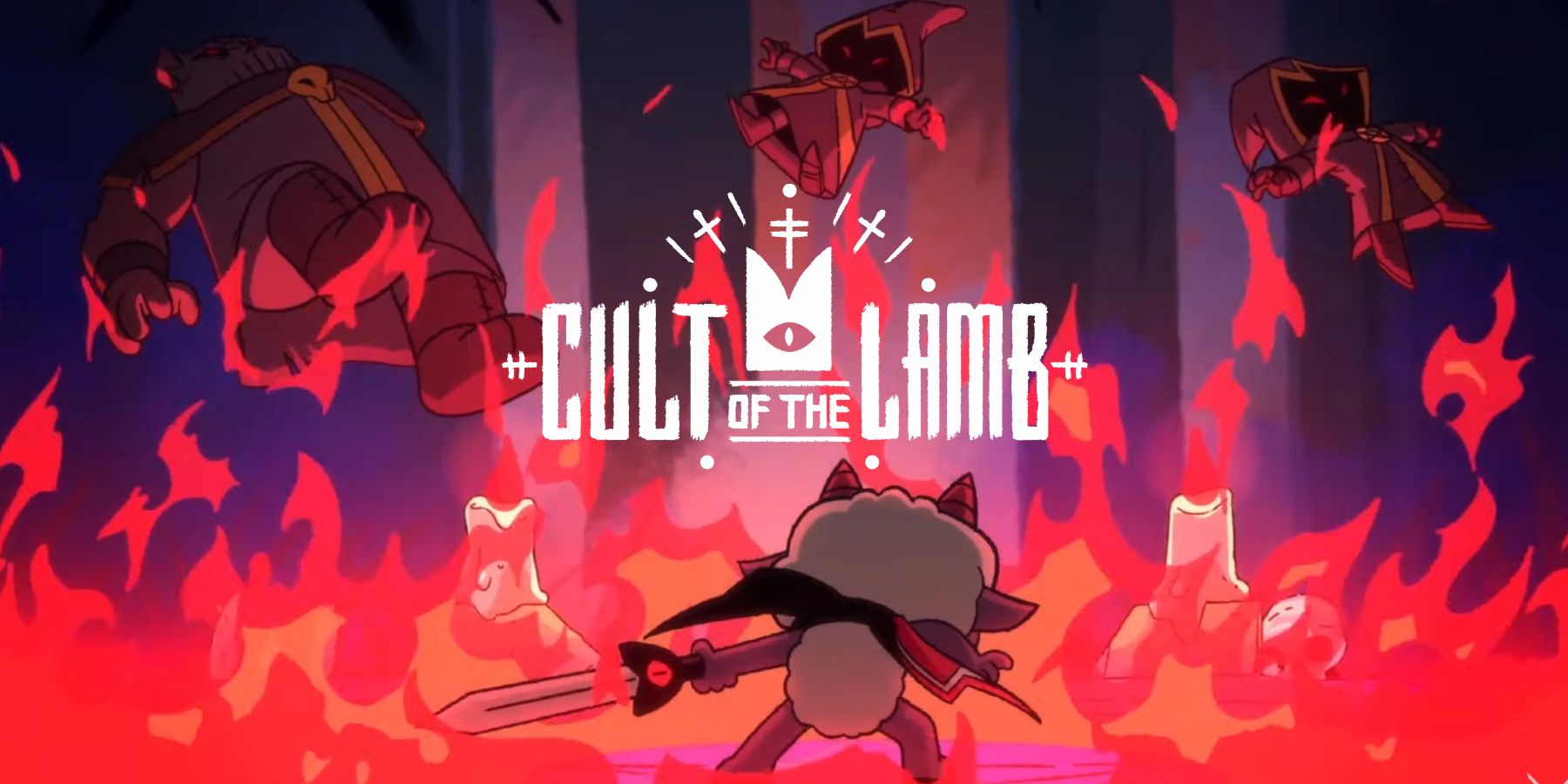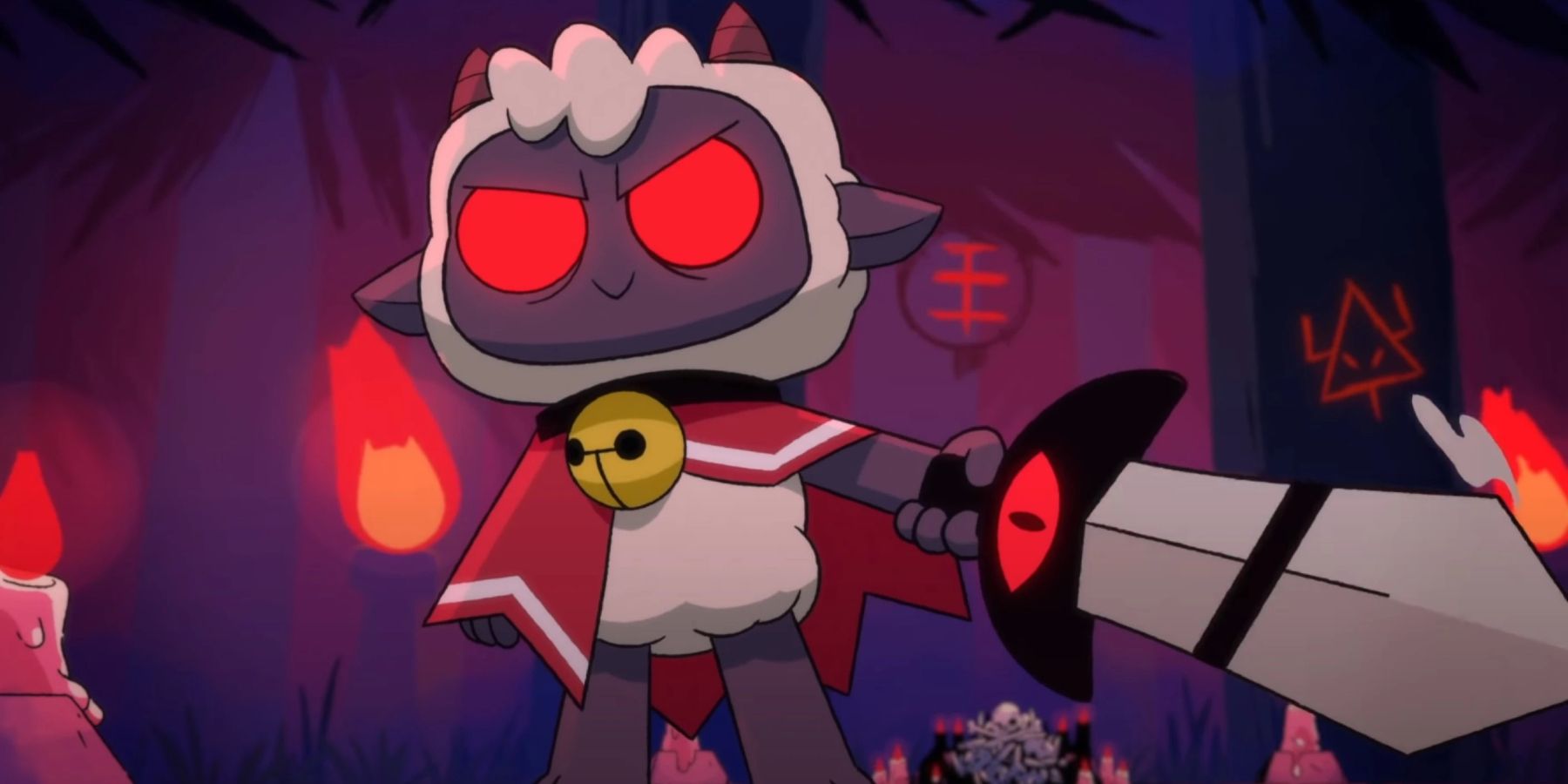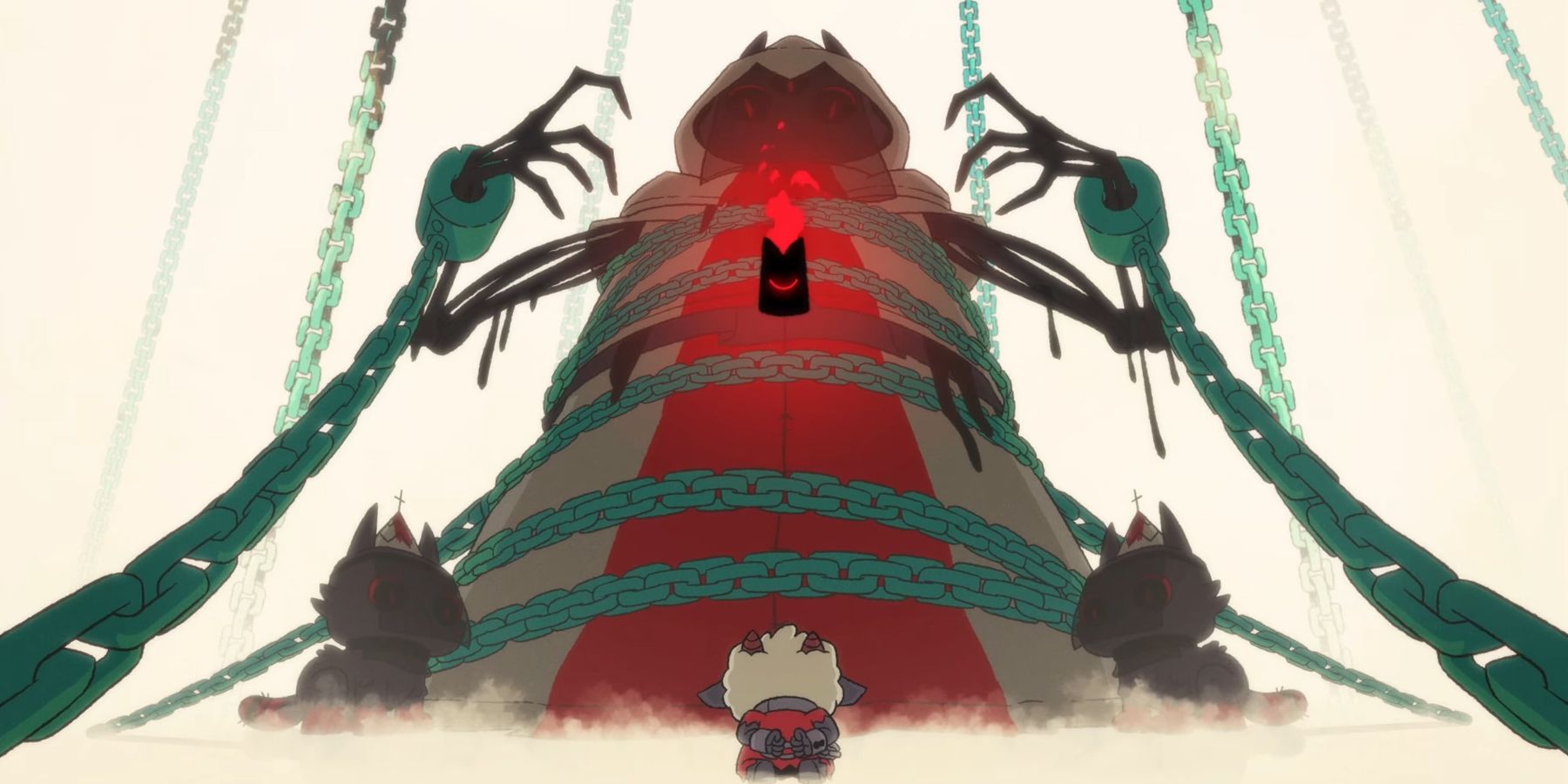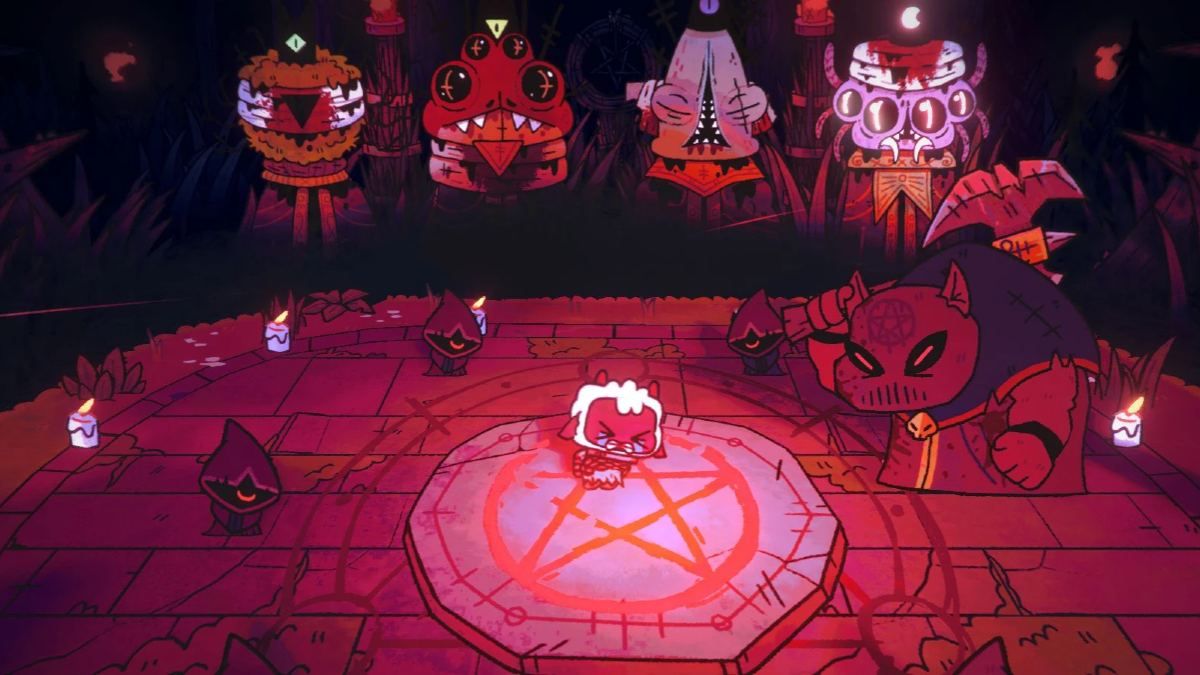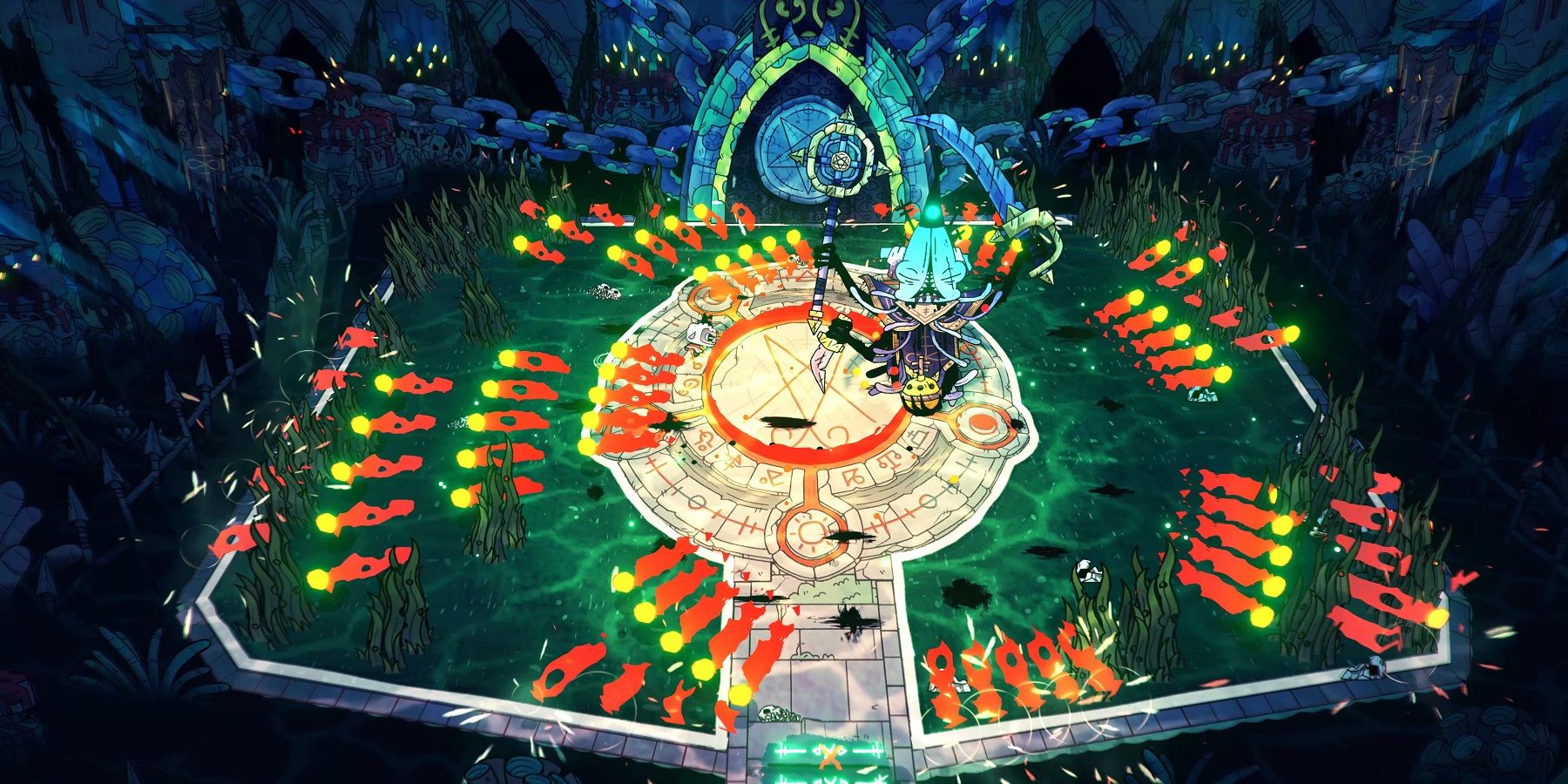The recently released Cult of the Lamb has not disappointed fans, despite being one of the most anticipated indie titles in recent memory. Boasting a unique blend between roguelike combat and city-building mechanics, the game thrives on its replayability and fresh experience.
Game Rant recently spoke to Cult of the Lamb art director James Pearmain about the title's early development concepts, gruesomely fun art style, and the inspiration behind some of its intimidating and memorable enemies. Interview has been edited for clarity and brevity.
Q: To start, what aspect of Cult of the Lamb’s development process was the most difficult to get absolutely right? Which part did you want to be absolutely perfect above all else?
A: The first big challenge we faced was just landing on the right idea. We knew we wanted to mix roguelike combat and resource gathering with some kind of base-building colony simulator, but it took us a long time to get to the idea of Cult of the Lamb. One initial concept was about Girl Scouts that grow magical weapons, then the game was a “make your own hell” afterlife simulator, then you played as a God and its tribe living atop a floating whale… We did a lot of work before eventually landing on the idea of running a cult of woodland animal worshippers.
The second-biggest challenge was making the 2 sides of the game work together in harmony. Traditionally in roguelikes, it's all about survival, getting as deep as you can, going on long runs and lasting for as long as possible... But we also wanted a day and night cycle, for your cult members to have their own daily routines and needs that would have to be met each day. Achieving these 2 things and making them work together in a smooth and accessible way took a lot of work and design iterations.
Q: Roguelikes have become more and more popular as a genre in recent years, what would you say is the largest factor that sets Cult of the Lamb apart from other roguelikes?
A: This is a game about running your own cult. There are randomized dungeons with combat and bosses and all the things you would expect from a traditional roguelike... But building, growing and running your cult is at the heart of the game. The base building colony simulator is just as important as the dungeon crawling, and the marriage of those two genres is what sets it apart from any other roguelike you have played.
Q: Would you say the game leans more towards dungeon crawler or city-builder sim, or is it a pretty even split?
A: It’s quite an even split - but we also wanted to give players the freedom to lean more into either side of the game if they want to. If you prefer spending time at your cult, there are ways of getting resources and new followers without leaving. If you’d rather spend more time out on crusades - you can do that too. Ultimately you’ll need to play both sides of the game to progress, but we did want to give some flexibility in where players can focus their time.
Q: The game is adorably dark, but how much of the evil is up to the player's discretion? Can you choose to lead your cult through kindness or fear?
A: We definitely wanted to give players the choice to be good or evil. If you want to treat your followers well and be a kind and respected leader - you can totally do that. If you want to be a tyrannical maniac that sacrifices any follower that doubts you and then makes the others eat poop - you can do that too!
As you progress through the game you will set new doctrines for your cult, and be given a choice between two different doctrine unlocks. Will you choose the wedding ritual and marry a follower, or the ritualistic fight pit and have two followers battle to the death? Will you choose the ability to inspire your followers and have them generate more faith, or the intimidate ability and scare them into working harder? The decisions that you make will help determine what kind of cult leader you become.
Q: The Four Bishops seem fascinating, how much of a looming threat do they pose throughout the game, and what was the process behind making each of them so unique?
A: Yes you will certainly see plenty of the Bishops! Without giving too much away, we do have a story that runs through the game, and you will encounter the Bishops more as you get deeper into each of the 4 realms. We wanted these encounters to surprise players as well as giving them some backstory and building the lore of the world.
In terms of their development process, like all characters in the game each Bishop is based around an animal, and they have their own realms that are based around these animals. Leshy is the Bishop of Darkwood and is a forest worm that can tunnel through the earth and has the strength of a mighty tree. Kallamar is the Bishop of Anchordeep and is a monstrous eldritch squid with many tentacles that summons jellyfish minions to fight against you. We wanted them to be scary mysterious beings that transform into huge monsters when you do eventually fight them.
Q: When a player gets seriously far into the game, what does a high power-level look like? Just how crazy do the late-game abilities get?
A: As you perform sermons in your temple you will draw power from your followers, unlocking new weapons and curses that will then appear on your crusades. You can also find and unlock new tarot cards that give various buffs and perks, and then rare shiny tarot cards that have even stronger effects! You can get pretty powerful, and certain combinations of weapons, curses and stacked tarots can be super effective together.
Q: It seems that followers in the game can get swayed by “false prophets,” will there be a kind of Town of Salem-esque social deduction mechanic to ascertain which members of the flock have been led astray, or does the player identify these followers through a different process?
A: It will be clear when one of your followers has lost faith in you. Unhappy followers will eventually dissent against you, and will loudly try to persuade others to leave your cult. It's up to you how to deal with this situation - will you calmly speak to them and reeducate them in the way of the Lamb? Will you throw them in prison for your other followers to laugh at? Will you sacrifice them to the gods in front of your other followers, or murder them at night when no one is watching, and then serve them up for breakfast? These are the decisions a leader must make.
Q: What was the art style process like in trying to find the perfect mix of adorable and grotesque, were there any limits that you set yourself in how extreme you were willing to take it?
A: The art style in our games has always leaned towards being quite cute and cartoony, so really it was the other way round - how can we make this world feel scary and dangerous when you’re away from the safety of your cult? These monsters look too cute, how can we make them scarier?! We decided quite early on that we wanted to bring in horror elements and darker themes to juxtapose with our cartoon style. We tried a lot of ideas to find the right vibe for the monsters and enemy cult leaders. We wanted them to be scary but not overly gruesome, and feel grounded in their natural environments, rather than appearing too supernatural or demon-like.
Q: You’ve spoken before about a post-launch roadmap for Cult of the Lamb, how does that look now that the game is nearing its release?
A: Yes we’ll be expanding the game beyond launch with free updates - we’re still working on the details of what will be in these. We’d like to react to the community once they start playing the game, and make sure we’re focused on the areas that people enjoy the most. We want to add more end game content and more things to do after beating the story. We want more enemies and weapons and depth to the combat. We want to add more buildings, more ways to interact with your followers and more follower forms… There's a lot we’d like to do!
You can expect a proper roadmap for the updates at some point after launch.
Q: You’ve also said before how you didn’t want to have “gore for the sake of gore” as seen in the likes of Happy Tree Friends, what are some of the ways in which you’ve given meaning and importance to the game’s gruesome art style?
A: We decided against the super violence route - our last game Never Give Up had lots of over the top cartoon gore and blood effects splashing everywhere, which was fun to do and gave a lot of satisfying visual feedback, but also pushed the game into feeling overtly cartoony and over the top. While the art style in Cult of the Lamb is still unapologetically cartoon, and we have curses and rituals and supernatural elements, we also wanted the visual direction to feel more natural and grounded within the cartoon style. The game still has moments of violence and horror, but we found if you do it all the time, then it loses its impact. Sometimes, less is more.
Q: What would you say is the biggest factor that influences the replayability of Cult of the Lamb?
A: As mentioned before, the doctrine choices mean that you can replay the game and choose a completely different set of rituals and ability unlocks, that will present different ways of playing and interacting with your followers. Some players might choose to be an evil overlord on their first playthrough, and then next time be a saintly leader that is kind and caring to their followers.
It's also a game that is bursting with customization options to unlock, with lots of decorations for your base and different animal forms for your followers. When you defeat a miniboss on a crusade, you send them back to your cult to be indoctrinated. You can then customize them and change their form - so you could have one playthrough where you have a cult full of friendly monsters, and another with a cult full of purple cannibal pigs. Your cult, your rules!
Q: What aspect of the game are you most excited for fans to explore?
A: The game has a colorful world to explore that is filled with interesting characters to meet. There are exciting randomly generated dungeons filled with horrific enemies and huge monstrous bosses to fight, and an epic story running through it - but the things we are most excited for players to experience are the stories that they themselves will create. We’ve tried to make a game filled with possibilities and systems that work together, and we hope the relationships and interactions you have with your followers are the moments that you will remember most of all.
Q: Is there anything you would like to add to inform fans before Cult of the Lamb’s release?
A: Just that we hope people enjoy the game, and do please keep a lookout for free updates in the future. We are looking at the launch version of the game as the origin story of the Lamb, and hope to grow the sizer and depth of game and its world in the coming months and years. Praise the Lamb!
[END]
Cult of the Lamb is available now for PC, PS4, PS5, Switch, Xbox One, and Xbox Series X/S.

